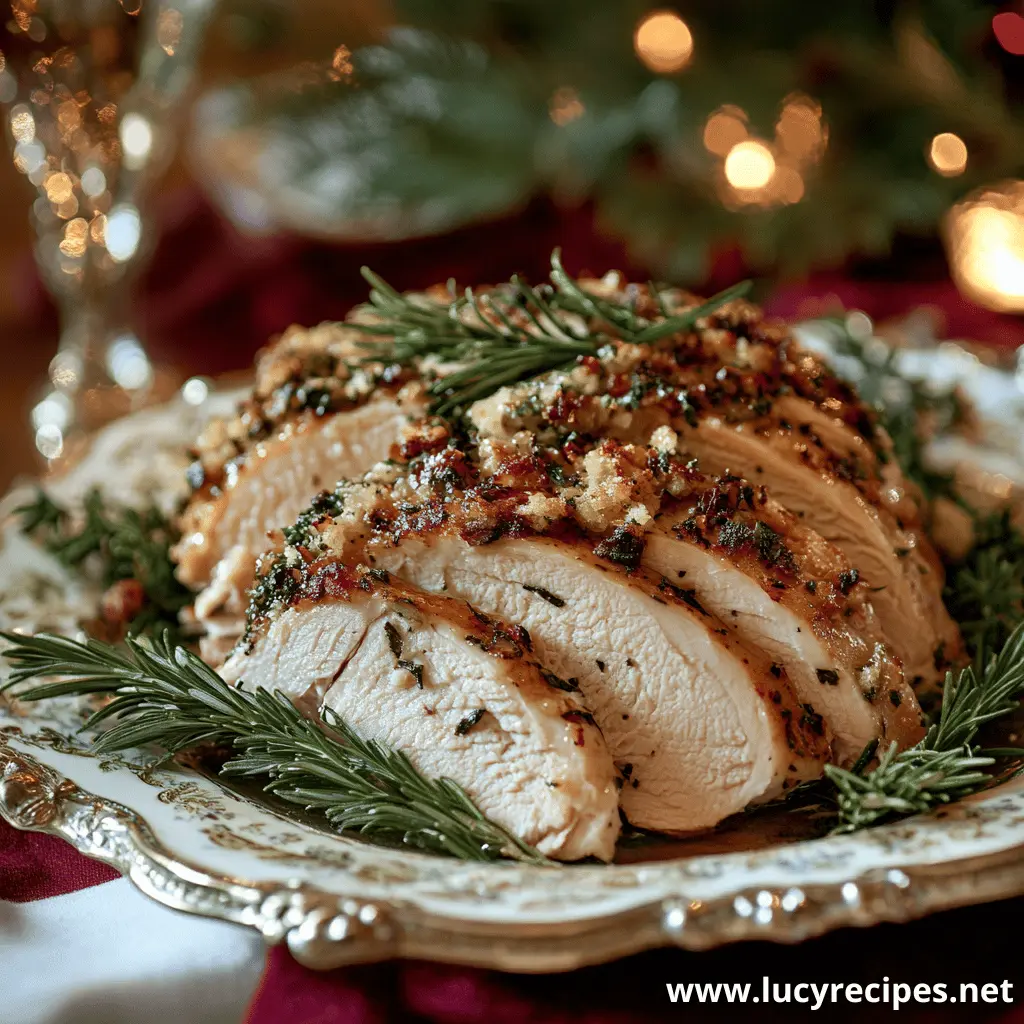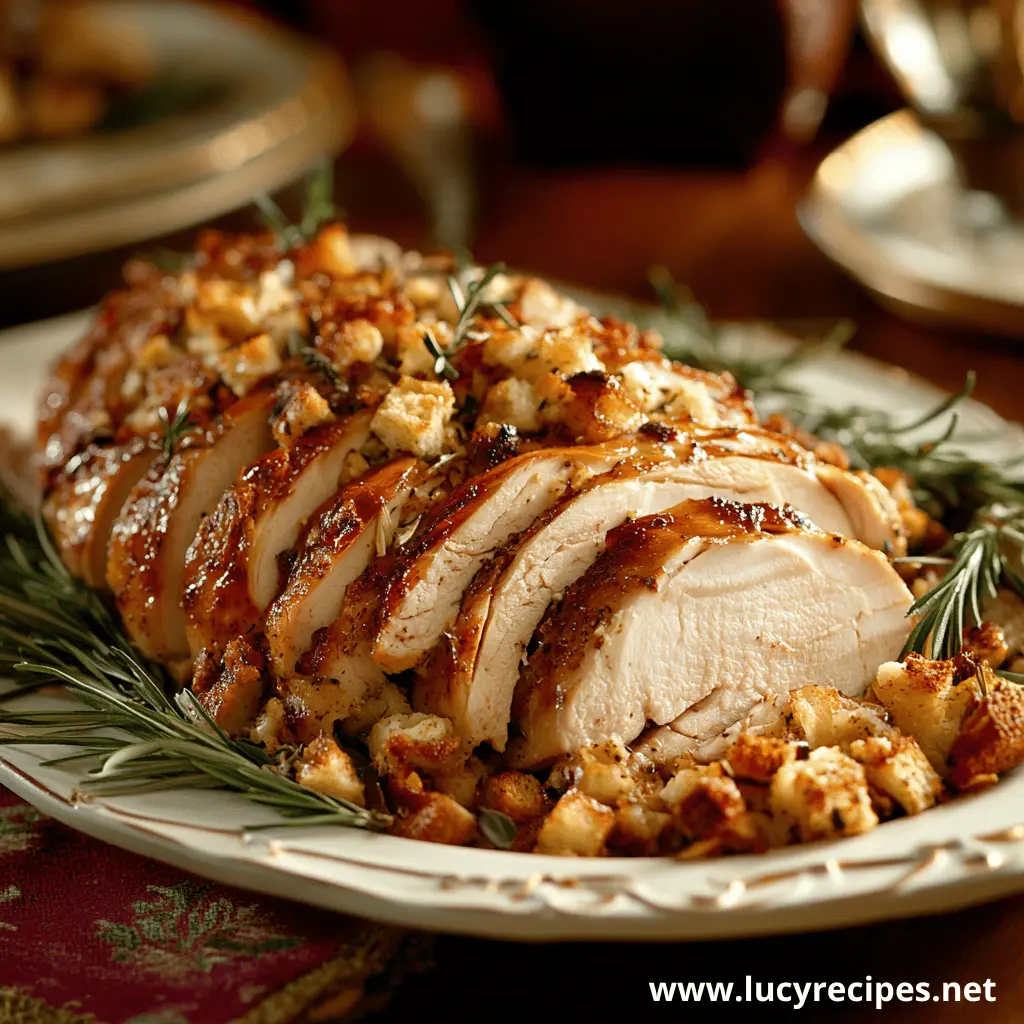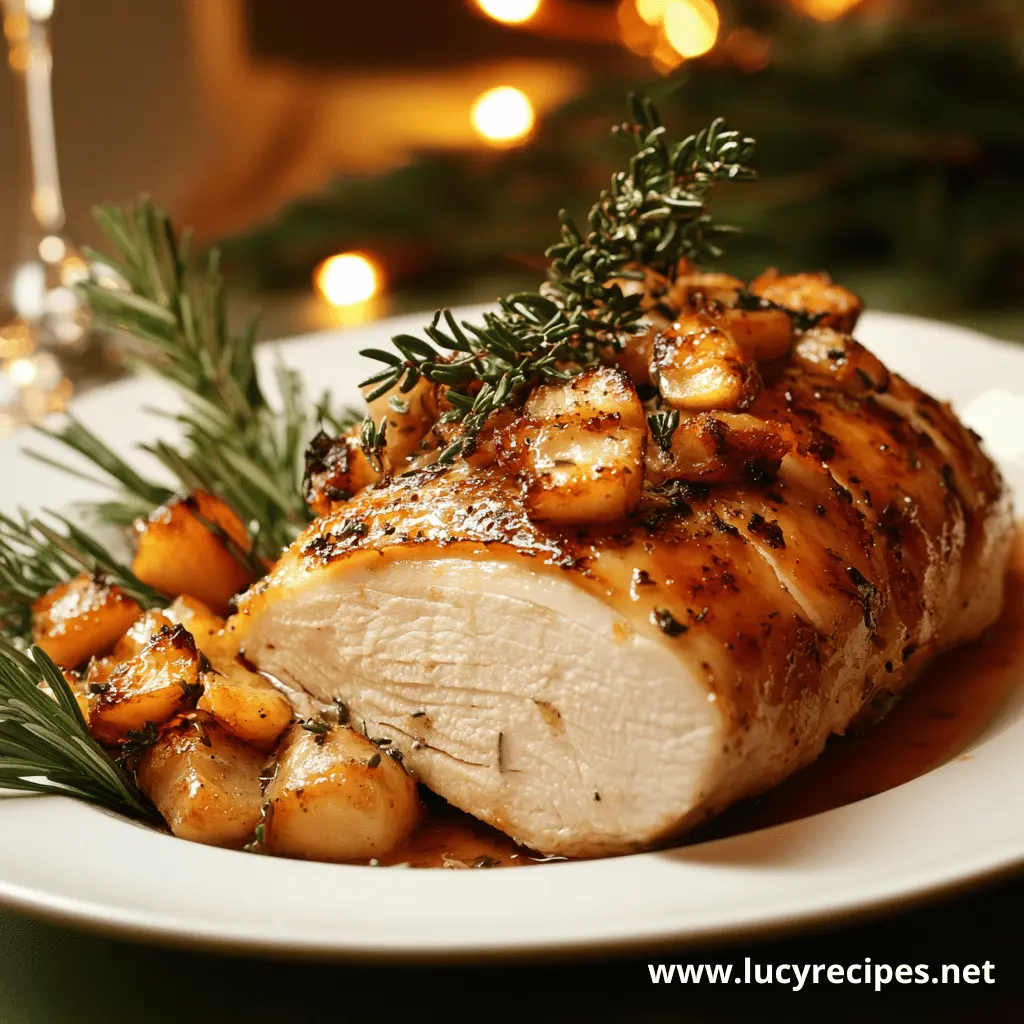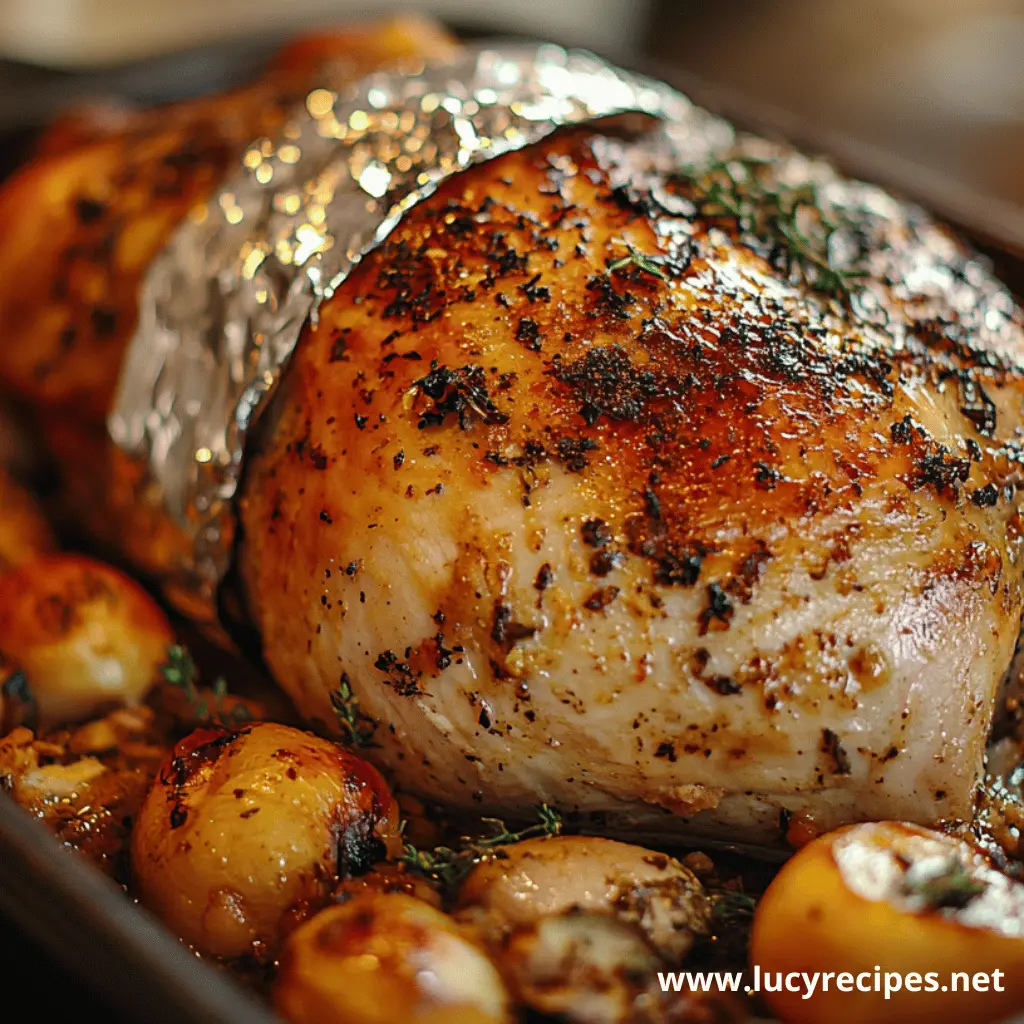Introduction to Baking Turkey Breast
Turkey breast is a favorite for its delicious flavor and lean protein, making it ideal for both holiday feasts and everyday meals. Its versatility and rich taste make it a centerpiece for various occasions. However, achieving perfectly baked turkey breast requires knowing whether to bake it covered or uncovered, as each method affects the dish’s texture, flavor, and moisture. In this guide, we’ll answer the question “Turkey Breast Covered or Uncovered?” while sharing tips on crafting a flavorful bread stuffing and serving it with your turkey breast.
Table of Contents
Covered vs. Uncovered: Understanding the Basics
When baking turkey breast, one of the key questions to consider is: Turkey Breast Covered or Uncovered? This decision plays a crucial role in determining how the turkey cooks and the final outcome.
Baking Covered
- Advantages: Retains moisture and prevents the meat from drying out.
- Drawback: Can lead to less browning and a softer skin texture.
- Best For: Those who prioritize juicy, tender meat.
Baking Uncovered
- Advantages: Promotes crispy, golden skin and a more roasted flavor.
- Drawback: May result in drier meat if not monitored closely.
- Best For: A visually appealing presentation and those who enjoy crispy textures.
By understanding whether to bake turkey breast covered or uncovered, you can choose the method that best aligns with your preferences and recipe goals.
Uncovered Baking Method: Flavor and Texture
Do you bake turkey breast covered or uncovered? Choosing the uncovered method emphasizes flavor and texture by creating a beautifully browned and crispy exterior. Here’s why some cooks prefer this approach:
- The uncovered method allows the hot air in the oven to circulate freely, creating a caramelized crust on the turkey breast.
- Herbs and spices in rubs or marinades form a flavorful crust when exposed directly to heat.
- While the meat can dry out more easily, using a baste or brine can help retain moisture.
When to Use the Uncovered Method
- When serving turkey breast as a main dish with crispy skin.
- For recipes where a deep golden color enhances the presentation.
- When you can closely monitor the cooking process to avoid overcooking.
If you’re aiming for the perfect blend of flavor and texture, baking uncovered may be your ideal choice.
Step-by-Step Guide to Baking Turkey Breast

Whether you bake covered or uncovered, following a structured process ensures a consistently delicious result. Here’s a step-by-step guide:
Preparation
- Choose the Right Cut: Opt for a fresh or thawed turkey breast of uniform size for even cooking.
- Preheat Your Oven: Set your oven to 350°F (175°C) as a standard temperature.
- Season Generously: Use a mix of salt, pepper, herbs, and spices. For added flavor, consider a marinade or brine.
Baking Process
- For Covered Baking: Place the turkey breast in a roasting pan and cover it with foil or a lid. Add a small amount of broth to the pan for steam.
- For Uncovered Baking: Place the seasoned turkey on a rack to elevate it, ensuring heat circulates evenly.
- Check periodically for internal temperature and baste with juices to enhance flavor.
Final Steps
- Use a meat thermometer to ensure the internal temperature reaches 165°F (74°C).
- Let the turkey breast rest for 10–15 minutes before carving to retain juices.
For more detailed preparation steps, check out our guide on how to make the perfect bread stuffing for turkey breast.
Temperature and Timing Tips for Perfect Turkey Breast
Temperature and timing are critical factors for achieving a perfectly baked turkey breast, regardless of whether you choose to bake it covered or uncovered.
Key Tips
- Set the Right Oven Temperature: 350°F (175°C) is ideal for most recipes.
- Monitor Internal Temperature: Insert a meat thermometer into the thickest part of the breast. Remove it from the oven once it hits 160°F, allowing carryover cooking to bring it to 165°F.
- Calculate Cooking Time: Plan for about 20 minutes per pound of turkey breast.
- Adjust for Covering: Covered baking may take slightly longer, while uncovered baking can be faster but requires frequent checking.
Common Adjustments
- If the turkey browns too quickly, tent it with foil halfway through baking.
- For uncovered baking, basting every 30 minutes can prevent the meat from drying out.
By carefully managing temperature and timing, you’ll achieve a moist and flavorful turkey breast every time.
Mistakes to Avoid When Baking Turkey Breast
Even experienced cooks can encounter challenges when baking turkey breast. Avoiding these common pitfalls ensures a flawless result:
1. Skipping the Thermometer
- Relying solely on timing can lead to overcooked or undercooked meat.
- Always use a thermometer to verify the internal temperature.
2. Ignoring Resting Time
- Cutting the turkey breast immediately after baking allows juices to escape.
- Let it rest for at least 10 minutes before slicing.
3. Overlooking Covering Options
- Do you bake turkey breast covered or uncovered? Not considering this question can affect your final result.
- Choose the method that aligns with your desired texture and flavor.
4. Underseasoning
- Turkey breast is naturally lean and benefits from bold seasoning.
- Don’t hesitate to use brines, marinades, or herb mixtures.
5. Neglecting Moisture Management
- For uncovered methods, baste regularly or use a pan with added liquid.
- For covered methods, ensure steam builds up by tightly sealing the foil.
By steering clear of these mistakes, you’ll elevate your turkey breast baking skills and impress your guests.
Adding Flavors: Marinades, Rubs, and Basting Tips
Enhancing the flavor of turkey breast involves strategic use of marinades, rubs, and basting techniques. These methods ensure your turkey breast is both tender and packed with flavor, whether you bake it covered or uncovered.
Marinades
- A good marinade typically includes an acid (like lemon juice or vinegar), oil, and seasonings.
- Marinate the turkey breast for at least 2–4 hours or overnight for optimal flavor absorption.
- Popular combinations include citrus-herb, garlic-soy, and honey-mustard.
Rubs
- Dry rubs are perfect for adding bold flavors directly to the surface.
- Mix spices like paprika, garlic powder, black pepper, and thyme for a classic turkey rub.
- Apply generously and let it sit for at least 30 minutes before baking.
Basting
- Basting is especially useful when baking turkey breast uncovered.
- Use melted butter, broth, or a marinade to baste the turkey every 20–30 minutes.
- This technique keeps the meat moist and enhances the overall flavor.
By experimenting with these techniques, you can customize the flavor profile of your turkey breast to suit any occasion.
Serving and Plating Ideas for Turkey Breast

Presentation plays a crucial role in enhancing the appeal of your turkey breast dish. Knowing how to plate it beautifully ensures your effort in baking turkey breast covered or uncovered is fully appreciated.
Slicing and Serving
- Allow the turkey breast to rest for 10–15 minutes before slicing to retain its juices.
- Slice thinly against the grain for tender, easy-to-eat portions.
- Arrange slices in an overlapping pattern on a large platter.
Garnishes
- Use fresh herbs like rosemary, thyme, or parsley for a vibrant touch.
- Add color with roasted vegetables such as carrots, Brussels sprouts, or sweet potatoes.
- For a festive presentation, include cranberry sauce or citrus slices.
Pairing Suggestions
- Pair with classic sides like mashed potatoes, stuffing, and green beans.
- For lighter meals, serve with a fresh salad or roasted asparagus.
Thoughtful serving and plating elevate your turkey breast, making it a centerpiece that’s as visually appealing as it is delicious.
Perfect Pairings for Bread Stuffing and Turkey Breast
Complement your turkey breast and bread stuffing with an array of side dishes and desserts to complete the meal.
- Sides: Pair with old-fashioned sweet potato casserole for a touch of sweetness and a creamy texture.
- Desserts: End on a high note with mini pecan tarts, which provide a delightful contrast to savory dishes.
Storage and Leftover Ideas

After enjoying your perfectly baked turkey breast, knowing how to store and repurpose leftovers ensures nothing goes to waste. Whether you baked the turkey covered or uncovered, proper storage keeps it fresh and safe to eat.
Storage Tips
- Refrigeration: Store turkey breast in an airtight container or tightly wrapped in foil. Use within 3–4 days.
- Freezing: Slice the turkey breast, place in freezer-safe bags, and freeze for up to 3 months. Thaw in the refrigerator before reheating.
Leftover Ideas
- Sandwiches: Use thin slices in a turkey club or panini with your favorite condiments.
- Soups: Add diced turkey to a hearty vegetable or noodle soup.
- Salads: Toss shredded turkey into a Caesar salad or grain bowl for added protein.
- Casseroles: Combine turkey with pasta, cheese, and vegetables for a comforting baked dish.
By storing and creatively repurposing leftovers, you extend the enjoyment of your turkey breast well beyond the initial meal.
FAQs
When it comes to baking turkey breast, questions often arise about the best methods. Below, we address some of the most common inquiries, including, “Do you bake turkey breast covered or uncovered?”
Do you bake turkey breast covered or uncovered?
- Baking covered helps retain moisture and is ideal for tender, juicy meat.
- Baking uncovered produces a crispy, golden-brown exterior but requires careful monitoring to prevent drying out.
How do you keep turkey breast from drying out when baking uncovered?
- Baste the turkey every 20–30 minutes with butter, broth, or juices.
- Consider starting covered, then uncovering it for the final 30 minutes.
What temperature should turkey breast be cooked to?
- The internal temperature should reach 165°F (74°C). Use a meat thermometer to check the thickest part of the breast.
Can you switch between covered and uncovered during baking?
- Yes, many cooks start with the turkey covered to lock in moisture and finish uncovered to crisp the skin.
Addressing these FAQs helps clarify techniques and ensures your turkey breast turns out perfectly every time.
Conclusion
Baking turkey breast to perfection involves understanding the nuances of flavor, moisture retention, and presentation. Whether you choose to bake it covered or uncovered, the method you select significantly influences the final dish. Using marinades, rubs, and basting techniques adds depth to the flavor, while proper serving and plating enhance the presentation.
By avoiding common mistakes, storing leftovers correctly, and repurposing them creatively, you maximize the enjoyment of your effort. Always remember the key question, “Do you bake turkey breast covered or uncovered?”, as this decision shapes your cooking process and the outcome.
Armed with these insights and tips, you’re well-equipped to prepare a turkey breast that’s not only delicious but also memorable. Happy cooking!


1 thought on “Do You Bake Turkey Breast Covered or Uncovered? Tips for Perfect Results”
Comments are closed.